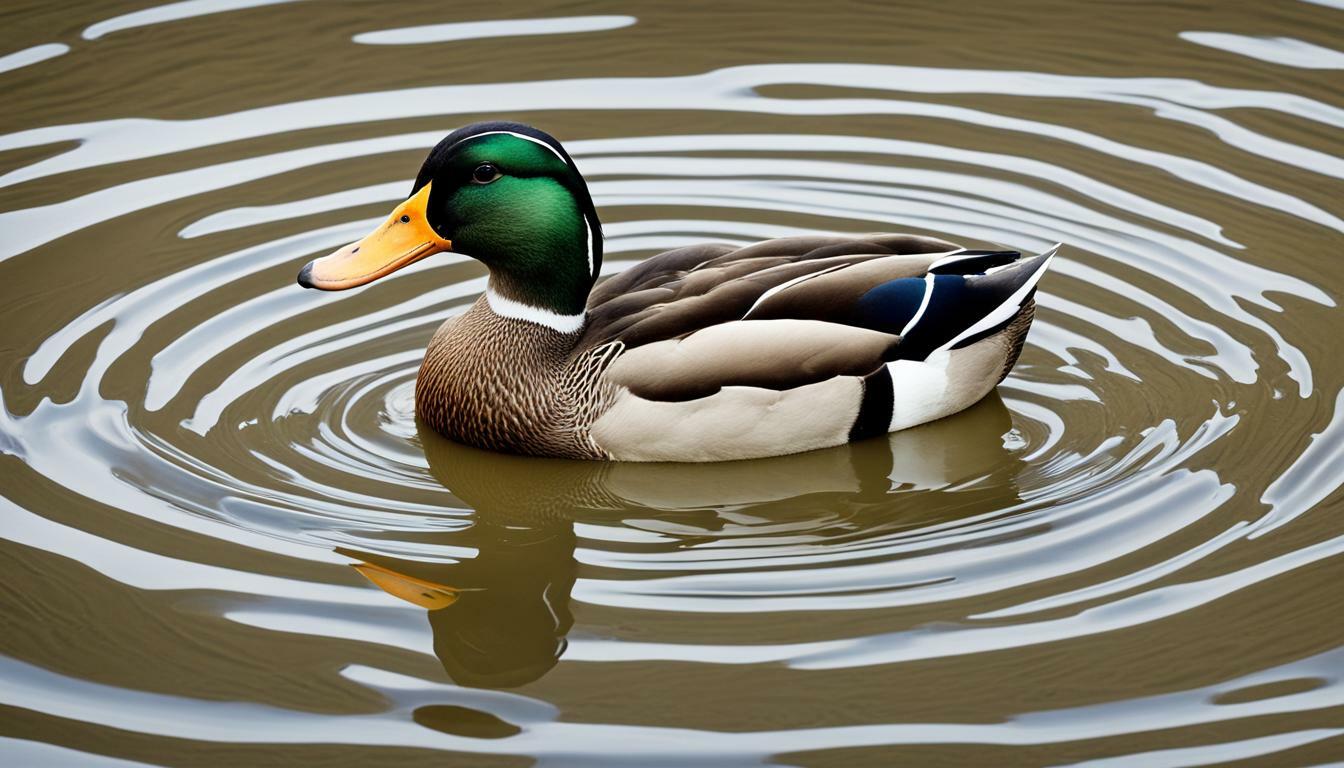If you’ve ever been near a pond or lake, you’ve probably seen ducks swimming and quacking away. But have you ever wondered if ducks have ears? They don’t have external ears like humans do, but they do have a unique auditory system that allows them to hear and benefit from their environment.
Let’s explore the hearing ability of ducks and how their ear structure enables this sense.
Key Takeaways:
- Ducks do have ears, but they don’t have external ears like humans.
- Ducks have a unique auditory system that allows them to hear and locate the source of sounds in their environment.
- The ear structure of ducks plays an important role in their hearing ability.
Understanding Duck Ear Structure
While it may not be immediately apparent, ducks do indeed have ears. Their ears are located on the sides of their head, just behind their eyes. Unlike humans, their ears are relatively small and are hidden by feathers.
The anatomy of duck ears includes both external and internal structures. The external ear is made up of a small opening covered by a flap of skin, called the operculum. The operculum functions to protect the ear from water and debris while still allowing sound to enter.
Inside the ear, ducks have a small ear canal that leads to the eardrum, or tympanic membrane. Behind the eardrum lies the middle ear, consisting of three small bones called the malleus, incus, and stapes. These bones work together to amplify and transmit sound waves to the inner ear.
The inner ear is where the real magic happens. It contains a fluid-filled chamber called the cochlea, which is lined with tiny hair cells that detect vibrations in the fluid. These vibrations are then transformed into electrical signals that travel to the brain, allowing the duck to perceive sound.
How does the ear structure allow ducks to hear?
The structure of the duck ear allows them to hear a wide range of frequencies, from low-pitched sounds like a quack to high-pitched sounds like a whistle. Their sense of hearing is also highly sensitive, allowing them to detect even the slightest sounds in their environment.
Ducks are able to locate the source of sound with great accuracy, thanks to their ability to process and compare the timing and intensity of sounds received by each ear. This helps them to pinpoint the location of potential predators or prey.
All in all, the anatomy and structure of the duck ear is a testament to the remarkable adaptations of these waterfowl. Despite being relatively small and hidden, their ears play a vital role in their survival and communication in the wild.
The Hearing Ability of Ducks
If you’ve ever wondered if ducks have ears, the answer is yes, they do. In fact, ducks have some of the most advanced auditory systems among birds.
Ducks have excellent hearing ability and can hear a wide range of frequencies, from low-pitched sounds to high-pitched sounds. They can also hear sounds that are much softer than what humans can detect, making them very sensitive to their surroundings.
The range of frequencies that ducks can hear well is between 500 Hz and 8,000 Hz. This range is similar to that of humans, but ducks are more sensitive to sounds in this range than we are. They can also hear sounds from much farther away than we can, as their hearing range extends up to 1000 feet.
Due to their exceptional hearing ability, ducks are able to distinguish between different sounds and locate their source accurately. This is particularly important for their survival, as they rely on their hearing to detect and avoid predators.
In summary, ducks can hear well and have a sensitive auditory system that enables them to be aware of their surroundings and stay safe from danger.
How Ducks Hear the World
Have you ever wondered how ducks are able to navigate through their surroundings with such ease? Their ability to hear plays a crucial role in their survival. So, how do they hear?
Like most birds, ducks have an auditory system that is different from ours. Sound waves travel through the air and are collected by their external ears, which are small openings located behind their eyes. These sound waves then travel through the duck’s ear canal and reach the eardrum, causing it to vibrate.
The next step in the process involves the three small bones located in the middle ear: the malleus, incus, and stapes. These bones amplify the vibrations from the eardrum and transfer them to the inner ear, which is where the real magic happens.
The inner ear contains the cochlea, a fluid-filled structure that is lined with hair cells. When the amplified vibrations reach the cochlea, they cause these hair cells to move, which sends electrical signals to the brain. It is these signals that the duck’s brain interprets as sound.
What makes the duck’s auditory system unique is its ability to filter out certain background noises and focus on specific sounds. This is made possible by the selective filtering of sounds in their middle ear and the unique structure of their cochlea.
Overall, the auditory system of ducks is well-equipped to handle a wide range of sounds in their environment, allowing them to locate potential predators, communicate with other ducks, and find food.
Comparing Duck Hearing to Other Birds
While ducks may not be the first bird species that comes to mind when thinking about hearing ability, they are actually quite impressive when it comes to auditory perception. Compared to other bird species, they have a relatively broad hearing range and are particularly sensitive to sounds in the mid-frequency range.
One unique aspect of duck hearing is their ability to locate the source of sound. They are able to do this by utilizing the time differences in which sound waves reach each ear. This is similar to how humans localize sound.
When compared to other waterfowl, such as geese and swans, ducks have a more acute sense of hearing. This is likely due to their smaller size and the fact that they are generally more agile and need to be alert to potential predators or threats.
Overall, while ducks may not be the most well-known bird for their hearing ability, they are certainly not lacking in this sense. Their unique characteristics and adaptations make them well-equipped to hear and react to their surroundings.
Conclusion
Now you know that ducks do have ears and that their auditory system is quite remarkable. Their unique ear structure allows them to hear a wide range of frequencies and locate sounds with great accuracy. Their sense of hearing is vital for their survival, helping them to detect predators and find food.
While ducks’ hearing ability is impressive, it varies among different bird species. Some birds, like owls, have even more advanced auditory systems that allow them to hunt in complete darkness.
Overall, ducks’ sense of hearing is just one fascinating aspect of these amazing birds. We hope you’ve enjoyed learning about their auditory world.
Can Ducks Hear the Sound of Peanuts Being Offered to Them?
Ducks’ peanut consumption depends on their ability to hear the sound of peanuts being offered to them. As excellent listeners, ducks possess sharp hearing, allowing them to pick up on the distinct cracking and rustling noises associated with peanuts. This keen sense of hearing enables them to locate and indulge in the irresistible treat, satisfying their fondness for peanuts.
FAQ
Q: Do ducks have ears?
A: Yes, ducks do have ears. While they may not have external ears like humans do, they have a highly developed auditory system that allows them to hear and interpret sounds in their environment.
Q: What is the structure of duck ears?
A: The structure of duck ears consists of both external and internal parts. The external ear is not visible as it is covered with feathers, but it helps funnel sounds into the ear canal. The internal ear includes the cochlea, which is responsible for converting sound vibrations into electrical signals that the brain can interpret.
Q: How well can ducks hear?
A: Ducks have excellent hearing abilities. They can detect a wide range of frequencies, including sounds that are beyond the range of human hearing. They are also sensitive to subtle changes in sound, allowing them to pick up on even the slightest noises in their environment.
Q: How do ducks hear the world around them?
A: Ducks hear the world through a process called sound transmission. When sound waves enter their ear canal, they travel through the ear and vibrate the eardrum. These vibrations are then transmitted to the cochlea, where they are converted into electrical signals that the brain can interpret as sound.
Q: How does duck hearing compare to other birds?
A: The hearing ability of ducks is comparable to that of other bird species. However, ducks have some unique adaptations in their auditory system that help them with their specific lifestyle and habitat. For example, their ability to locate the source of sound is highly developed, which is important for evading predators and finding food.










